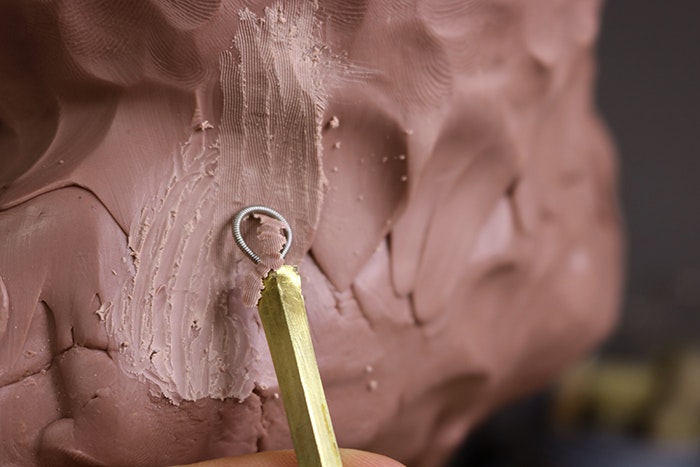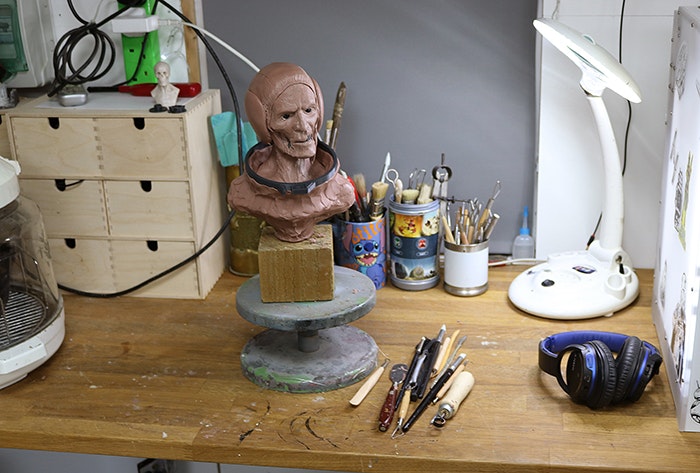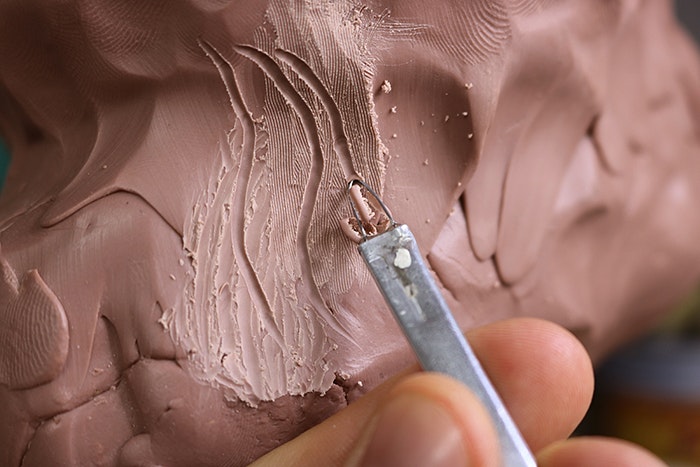An Introduction to Sculpting Tools
- Behind the Scenes
- Tutorials
- Posted by Andrew Hamilton on October 27 2016
Share Tweet
One of the most frequent questions I get asked when I talk about or show any of my work is ‘what clay do you use’ or ‘what tools do you use’, so I thought it would be good to share some of the tools etc. that I use in working in traditional 3D mediums.

Before going into the details, it should be pointed out that special types of tools and clay is not going to be a magic wand to make all your art better, I’ve seen artists who work with regular water based clay and their hands to create stunning works of art (see this sculpting demo by Philippe Faraut and check out his site for incredible instructional books to purchase).
It’s very important when working with clay to use your hands and fingers as much as possible, only switching to a tool when your hands cannot achieve something specific.
Workspace
Ensure you have a section of table that’s big enough to work on, remember you don’t need a whole table (depending on the size of your work). If you don’t have a dedicated workbench, be sure and put down something to protect the surface of the table from getting covered in clay or scratched from tools. I use various tubs and old cups to hold all my tools, you can really use anything to store the tools in. a handy desk light is always essential to keep your area well lit.
It’s a good idea to surround yourself with reference of real life and other inspiring art. As discussed in my previous post about having a mini library for yourself, it’s also good to have some more select images and 3D models handy right beside your workspace.

Tools
This is a small selection of my most frequently used tools. The 5 tools on the far right are home made myself, and the rest are store bought. It’s always easier to make your own tools as you can be more specific to your needs and techniques than store bought ones.

Let’s break down these tools further
1. Wire tipped tool - homemade tool with stiff wire coming out the top - this is good for dragging across the surface of your sculpt to give random wrinkles, that then can be smoothed out with brushes
2. Twisted wire rake - twist 2 or more wires together and then bent into a loop, this tool is great for raking across a surface to blend lumps and bumps together

3. Guitar loop - using an old guitar string gives a finer version of the twisted wire rake and works the same way only on a finer scale

4. Fine loop - solid wire loop bent into a point, can be used to gouge out lines and wrinkle detail
5. Mini wire brush - made using a clump of wires from a wire brush embedded in a chopstick, can be used to smooth out hard to reach areas

6. These are ball end tools bough online, they mimic what the tips of your fingers can do by pushing and dragging clay around but at a smaller scale. They come in many different sizes
7. Loop cutters - more standard tools that are great for carving into your sculpt
8. Rubber tipped tools - these are sometimes used for paintings, but I find them fantastic for blending sections of clay together, they come in many shapes and sizes
9. Brushes - regular brushes that are great for blending the clay, can be used dry or wetted with isopropyl alcohol to really smoothen out the clay

10. Heavy duty loop tool - this is usually for cutting large coils of clay out of a fresh block of clay, or if you have a jumbo sculpture!
Types of clay
There are hundreds of different brands, mixtures and types of clay available, the 2 types that I use are Chavants NSP Medium and Monster Clay. Both are oil based clays, so they never dry out like pottery, but they are quite hard when they are cold, so they need to be warmed up either in your hand, or with some sort of heater. Both clays can be melted down into a liquid, like wax, to be poured into moulds etc. they best thing about these clays is that they are completely recyclable, you can melt it down over and over again, so once you have a block of either, it will last a long time.
One last trick for using these clays is to invest in a mini table top oven, there are many different types, this is my one, the best thing about it is being able to set it on a low heat (60C) for an hour or so, it really makes the clay nice and easy to use. Monsterclay comes in an ovenable or microwaveable tray, and for the Chavant I use a simple clean tin foil tray that you can get in most grocery stores.

Andrew Hamilton
Andrew is Art Director on Doc McStuffins- see his work at [url="http://andrewhamiltoncreations.blogspot.ie/"] Andrew Hamilton Creations[/url]
http://andrewhamiltoncreations.blogspot.ie/
We Love Animation®
Brown Bag Labs is an exciting online space, brought to you by Brown Bag Films. We share great content for families as well as behind the scenes fun and tutorials from the Brown Bag Films team.









Get our great newsletter!
Get our great newsletter!